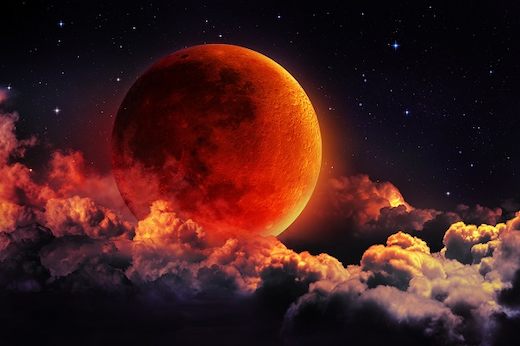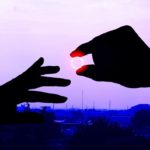During ancient times when the moon turned into blood red, it was associated with evil.

For instance, Mayans and Mesopotamian thought that the moon was being attacked by something evil. Other empires like the Chinese would retaliate by firing back to help the moon survive the dragon invasion.
Today, the moon does not need our protection.
This phenomena happens when the full moon goes directly behind the earth, while the sun, earth and moon are aligned and moon is closer to the earth. making it be referred as Lunar Eclipse.
The moon appears red due to the scattering effect of the light rays during the sunset and sunrise in other day areas on earth. The red light reflected from the moon is the refracted bluer light by the earth atmosphere.
This means that only countries experiencing night are able to experience the rare moment.
Lunar eclipse is the opposite of Solar Eclipse, where now the moon comes in-front of the earth, blocking light from the sun thus turning days into darkness

The term red moon is majorly used due to two reasons, first due to the colour the moon gives back. Red is associated with blood.
Second was coined by two pastors Mark Blitz and John Hagee after the 2014 lunar eclipse did not coincided with the Passover and Tabernacles festive but also matched the “moon turning to blood” described in the Book of Joel of the Hebrew Bible.
This day of 15th April 2015 also was thought to be the second coming of Jesus Christ among some Christians.
Kenyans among the lucky to view the eclipse
Kenyans would be among the few who will be presented with an opportunity to watch a total luna eclipse on Friday night.
The eclipse will last for a duration of more than 4 hours, being the longest ever recorded in history of 21st century. The eclipse which will last for 103 minutes will be the second in the year 2018 after the first was experienced in January 31st.
The eclipse will begin on Friday 8:14pm and ends on Saturday 2:28am however in Nairobi it will be visible from 10.30pm to 12.13 midnight. During then the moon will be blood red in colour for a total of about 107 minutes.
The last time Kenyans enjoyed such moments were on September 28 2015 where partial solar and lunar eclipses.
The luna eclipse will also be visible in Eastern Africa, and Central Asia, seen rising over South America, Western Africa, and Europe, and setting over Eastern Asia, and Australia.














